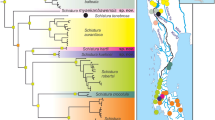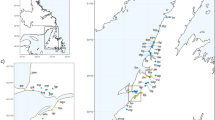Abstract
Being a group of popular model organisms in eco-evolutionary biology, genetic, and genomic research studies, the genus Pungitius with 12 species is the most species-rich genus in the stickleback family Gasterosteidae including the Caspian nine-spine stickleback, Pungitius platygaster (Kessler, 1859), the only known species from southern Caspian Sea basin. Here, the new data based on morphological and molecular characters of the mtDNA COI barcode region, and current distribution range of P. platygaster is presented. These data confirm the validity of P. platygaster among its congeners, being sister clade to P. hellenicus from Greece. Morphologically, it is distinguished from the other congeneric species by complete pelvic girdle, 8−11 dorsal spines, and presence of large lateral scutes. The Caspian nine-spine stickleback is found in several closely placed freshwater and brackish waterbodies in the southern Caspian Sea.





Similar content being viewed by others
REFERENCES
Abbasi, K., Valipour, A., Talebi Haghighi, D., et al., Atlas of Iranian Fishes, Gilan Inland Waters, Rasht: Gilan Fish. Res. Centre, 1999.
Abdoli, A. and Naderi, M., Biodiversity of Fishes of the Southern Basin of the Caspian Sea, Tehran: Abzian Sci. Publ., 2009.
Bruford, M.W., Hanotte, O., Brokfield, J.F.Y., and Burke, T., Single-locus and multilocus DNA fingerprinting, in Molecular Genetic Analysis of Populations: A Practical Approach, A.R. Hoelzel, Ed., Oxford: IRL Press, 1992, pp. 225–269.
Coad, B.W., Review of the sticklebacks and pipefishes of Iran (Families Gasterosteidae and Syngnathidae), Iran. J. Ichthyol, 2015, vol. 2, no. 3, pp. 133–147. https://doi.org/10.22034/iji.v2i3.63
Darriba, D., Taboada, G.L., Doallo, R., and Posada, D., jModelTest 2: More models, new heuristics and parallel computing, Nat. Methods, 2012, vol. 9 no. 8, Article 772. https://doi.org/10.1038/nmeth.2109
Denys, G. P., Persat, H., Dettai, A., et al., Genetic and morphological discrimination of three species of ninespined stickleback Pungitius spp. (Teleostei, Gasterosteidae) in France with the revalidation of Pungitius vulgaris (Mauduyt, 1848). J. Zool. Syst. Evol., 2018, vol. 56, no. 1, pp. 77−101. https://doi.org/10.1111/jzs.12178
Esmaeili, H. R., Mehraban, H., Abbasi, K., et al., Review and updated checklist of freshwater fishes of Iran: Taxonomy, distribution and conservation status, Iran. J. Ichthyol., 2017, vol. 4, Suppl. 1, pp. 1−114.
Esmaeili, H.R., Sayyadzadeh, G., Eagderi, S., and Abbasi, K., Checklist of freshwater fishes of Iran, FishTaxa, 2018, vol. 3 no. 3, pp. 1–95.
Fricke, R., Eschmeyer, W.N., and van der Laan, R., Eschmeyer’s catalog of fishes: Genera, Species, References, Version 04/2023, 2023. http://researcharchive.calacademy.org/ research/ichthyology/catalog/fishcatmain.asp.
Hall, T.A., BioEdit: A user-friendly biological sequence alignment editor and analysis program for Windows 95/98/NT, Nucl. Acids Symp Ser., 1999, vol. 41, pp. 95–98. https://doi.org/10.14601/Phytopathol_Mediterr-14998u1.29
Huelsenbeck, J.P. and Ronquist, F., MrBayes: Bayesian inference of phylogeny, Bioinformatics, 2001, vol. 17, no. 8, pp. 754–755. https://doi.org/10.1093/bioinformatics/17.8.754
Kapli, P., Lutteropp, S., Zhang, J., et al., Multi-rate poisson tree processes for single-locus species delimitation under Maximum Likelihood and Markov Chain Monte Carlo, Ibid., 2017, vol. 33 no. 11, pp. 1630–1638. https://doi.org/10.1093/bioinformatics/btx025
Kawahara, R., Miya, M., Mabuchi, K., et al., Stickleback phylogenies resolved: Evidence from mitochondrial genomes and 11nuclear genes, Mol. Phylogen. Evol., 2009, vol. 50, no 2, pp. 401–404. https://doi.org/10.1016/j.ympev.2008.10.014
Keivany, Y., Taxonomic revision of the genus Pungitius with emphasis on P. hellenicus, Master’s Thesis, Edmonton: University of Alberta, 1996.
Keivany, Y. and Nelson, J.S., Phylogenetic relationships of sticklebacks (Gasterosteidae), with emphasis on ninespine sticklebacks (Pungitius spp.), Behaviour, 2004, vol. 141, no. 11/12, pp. 1485–1497. https://doi.org/10.1163/1568539042948187
Keivany, Y., Nelson, J.S., and Economidis, P.S., Validity of Pungitius hellenicus Stephanidis, 1971 (Teleostei, Gasterosteidae), a stickleback fish from Greece, Copeia, 1997, vol. 1997, no. 3, pp. 558−564. https://doi.org/10.2307/1447559
Khara, H. and Nezami Baluchie, S., Studying fish biodiversity and abundance in Boujagh Wetland of Kiashar, south-western Caspian Sea, Iran. Fish. Sci. J., 2005, vol. 13 no. 4, pp. 41–54.
Kiabi, B.H., Abdoli, A., and Naderi, M., Status of the fish fauna in the South Caspian Basin of Iran, Zool. Middle East, 1999, vol. 18, pp. 57–65.
Kottelat, M. and Freyhof, J., Handbook of European Freshwater Fishes, Berlin, Cornol: Kottelat and Freyhof, 2007.
Matsumoto, T., Matsuura, K., and Hanzawa, N., A new species of nine-spined stickleback, Pungitius modestus (Gasterosteiformes, Gasterosteidae), from northern Honshu, Japan, Zootaxa, 2021, vol. 5005 no. 1, pp. 1–20. https://doi.org/10.11646/zootaxa.5005.1.1
Mattern, M.Y. and McLennan, D.A., Total evidence phylogeny of Gasterosteidae: Combining molecular, morphological and behavioural data, Cladistics, 2004, vol. 20, pp. 14–22. https://doi.org/10.1111/j.1096-0031.2004.00005.x
Merilä, J., Nine-spined stickleback (Pungitius pungitius): An emerging model for evolutionary biology research, Ann. N. Y. Acad. Sci., 2013, vol. 1289 no. 1, pp. 18–35. https://doi.org/10.1111/nyas.12089
Münzing, V.J., Variabilität, Verbreitung and Systematik der Arten und Unterarten in der Gatting Pungitius Coste, 1848 (Pisces, Gasterosteidae), Z. Zool. Syst. Evol. Forsch, 1969, vol. 7, no. 1, pp. 208–233.
Posada, D. and Crandall, K.A., MODELTEST: Testing the model of DNA substitution, Bioinformatics, 1998, vol. 14, pp. 817–818. https://doi.org/10.1093/bioinformatics/14.9.817
Sawada, Y., Phylogeny and zoogeography of the superfamily Cobitoidea (Cyprinoidei, Cypriniformes), Hokkaido Univ., 1982.
Stamatakis, A., RAxML-VI-HPC: Maximum likelihood-based phylogenetic analyses with thousands of taxa and mixed models, Bioinformatics, 2006, vol. 22, pp. 2688–2690. https://doi.org/10.1093/bioinformatics/btl446
Tamura, K., Stecher, G., Peterson, D., et al., MEGA6: Molecular evolutionary genetics analysis version 6.0, Mol. Biol. Evol., 2013, vol. 30, pp. 2725–2729. https://doi.org/10.1093/molbev/mst197
Varadharajan, S., Rastas, P., Löytynoja, A., et al., A high-quality assembly of the nine-spined stickleback (Pungitius pungitius) genome, Gen. Biol. Evol., 2019, vol. 11, no. 11, pp. 3291–3308. https://doi.org/10.1093/gbe/evz240
Wang, Y., Wang, Y., Zhao, Y., et al., Phylogenomics of Northeast asian Pungitius sticklebacks, Divers. Distrib., 2021, vol. 28, no. 12, pp. 2610–2621. https://doi.org/10.1111/ddi.13423
Ward, R.D., Zemlak, T.S., Innes, H.B., et al., DNA barcoding Australia’s fish species, Philos. Trans. R. Soc. Lond., B, Biol. Sci., 2005, vol. 360, no. 1462, pp. 1847–1857. https://doi.org/10.1098/rstb.2005.1716
Zhang, J., Kapli, P., Pavlidis, P., and Stamatakis, A., A general species delimitation method with applications to phylogenetic placements, Bioinformatics, 2013, vol. 29 no. 22, pp. 2869–2876. https://doi.org/10.1093/bioinformatics/btt499
Ziuganov, V.V. and Gomeluk, V.Y., Hybridization of two forms of ninespine stickleback, Pungitius pungitius and P. platygaster, under experimental conditions and an attempt to predict the consequences of their contact in nature, Environ. Biol. Fish., 1985, vol. 13, no. 4, pp. 241−251. https://doi.org/10.1007/BF00002908
ACKNOWLEDGMENTS
We are pleased to thank Shiraz University for financial support and F. Zarei (Shiraz University) for preparing the map.
Funding
The research work was funded by Shiraz University.
Author information
Authors and Affiliations
Corresponding author
Ethics declarations
ETHICS APPROVAL AND CONSENT TO PARTICIPATE
All applicable international, national, and/or institutional guidelines for the care and use of animals were followed. The research was approved by Ethics Committee of Biology Department (SU-9233856).
CONFLICT OF INTEREST
The authors of this work declare that they have no conflicts of interest.
AUTHOR CONTRIBUTION
All the authors contributed to the study conception and design. Fish collection was made by K. Abbasi. Material preparation, and analysis were performed by H.R. Esmaeili and G. Sayyadzadeh. The first draft of the manuscript was written by H.R. Esmaeili and G. Sayyadzadeh. All authors commented on previous versions of the manuscript. All authors read and approved the final version of the manuscript.
Additional information
Publisher’s Note.
Pleiades Publishing remains neutral with regard to jurisdictional claims in published maps and institutional affiliations.
Rights and permissions
About this article
Cite this article
Esmaeili, H.R., Sayyadzadeh, G. & Abbasi, K. New Morphological and Molecular Data on the Southern Ninespine Stickleback, Pungitius platygaster (Gasterosteidae) from Southern Caspian Sea Basin. J. Ichthyol. 63, 1062–1071 (2023). https://doi.org/10.1134/S0032945223060036
Received:
Revised:
Accepted:
Published:
Issue Date:
DOI: https://doi.org/10.1134/S0032945223060036




